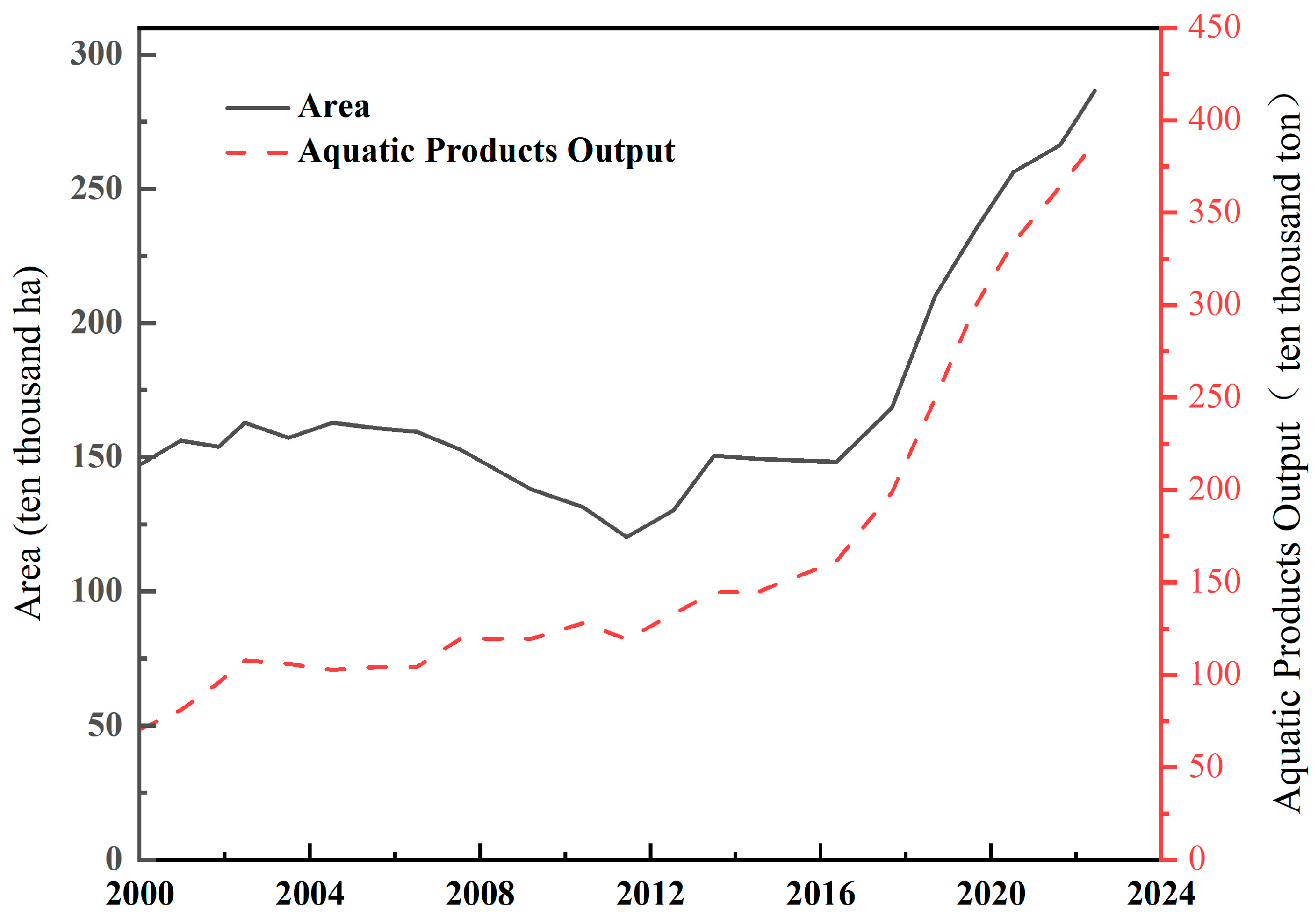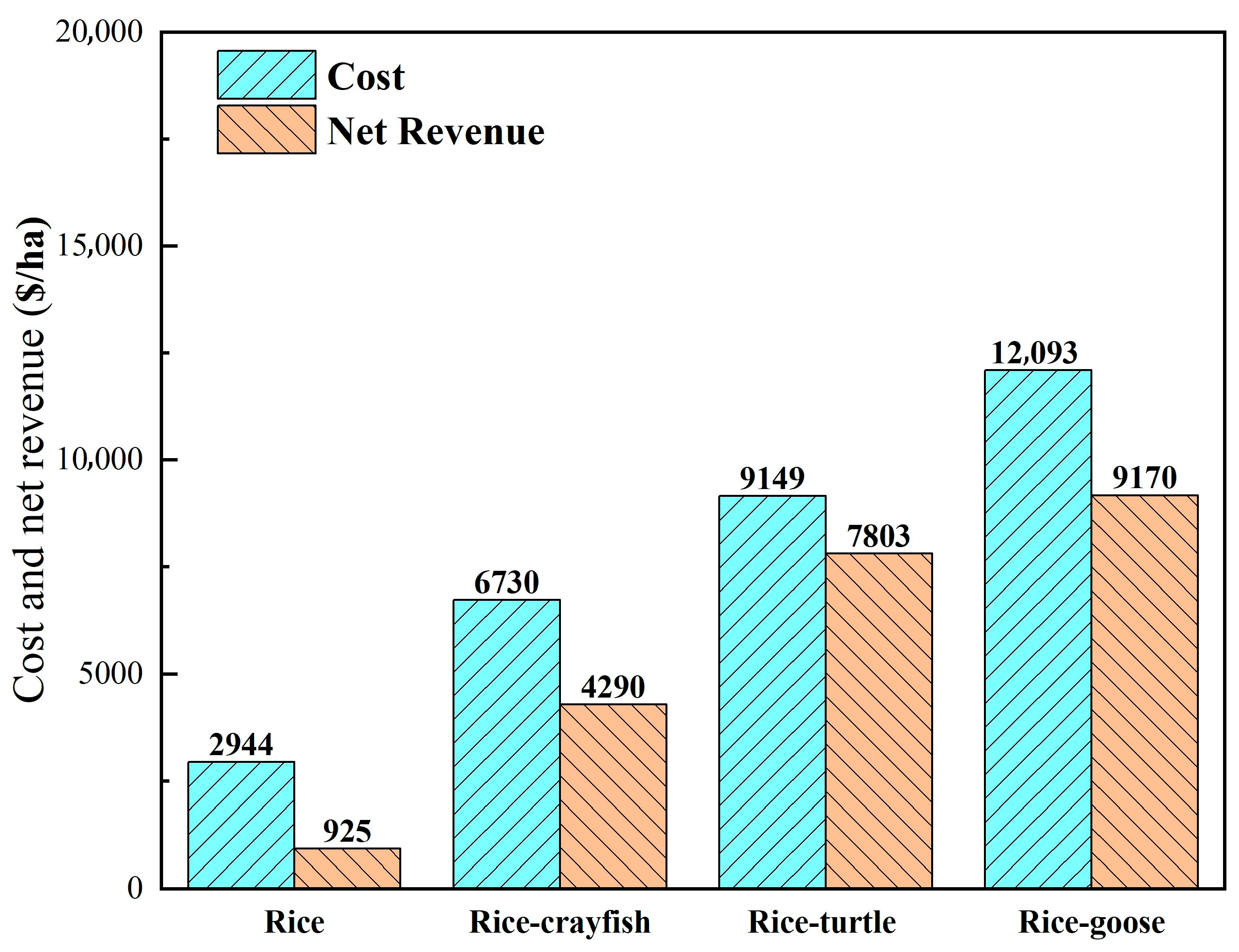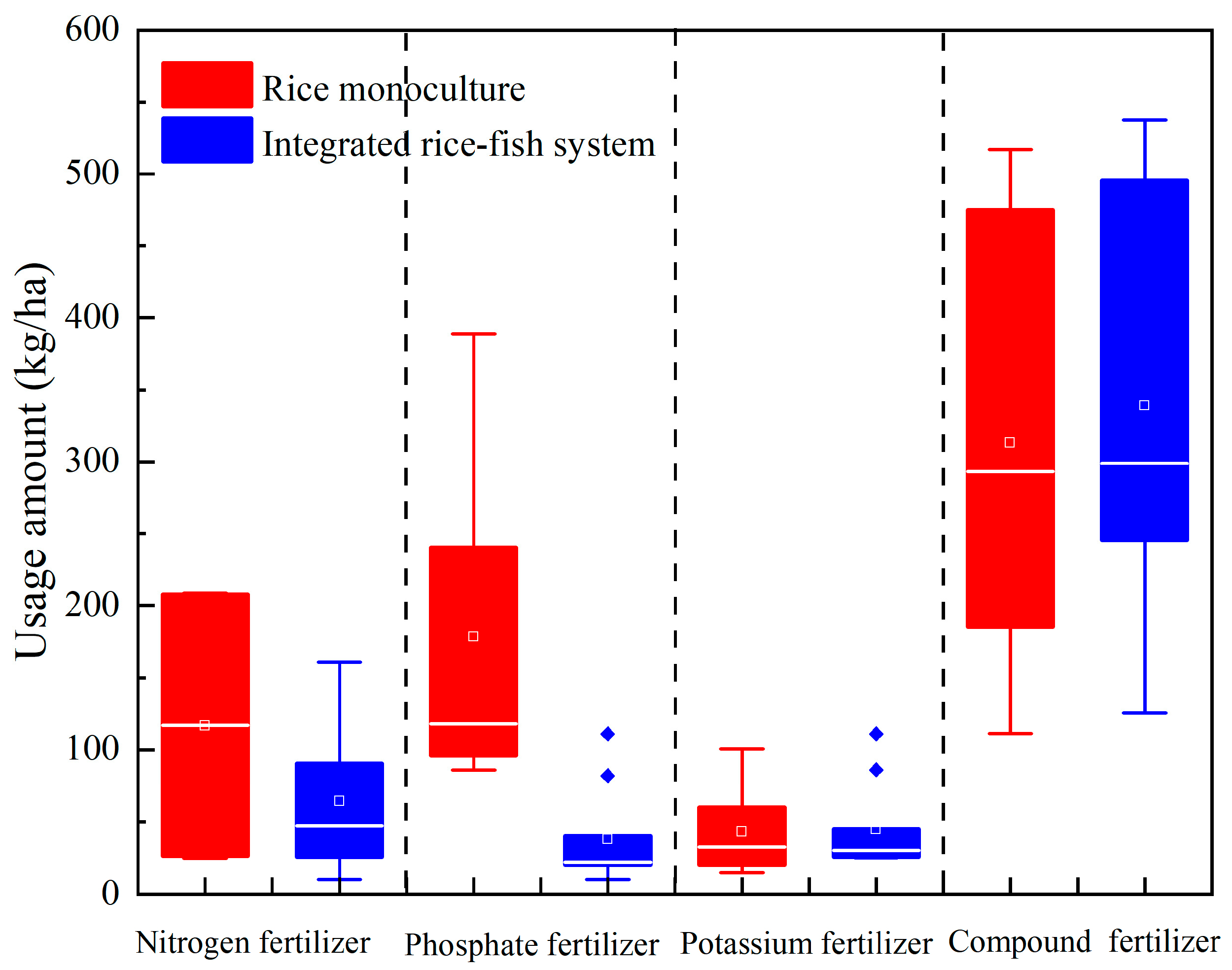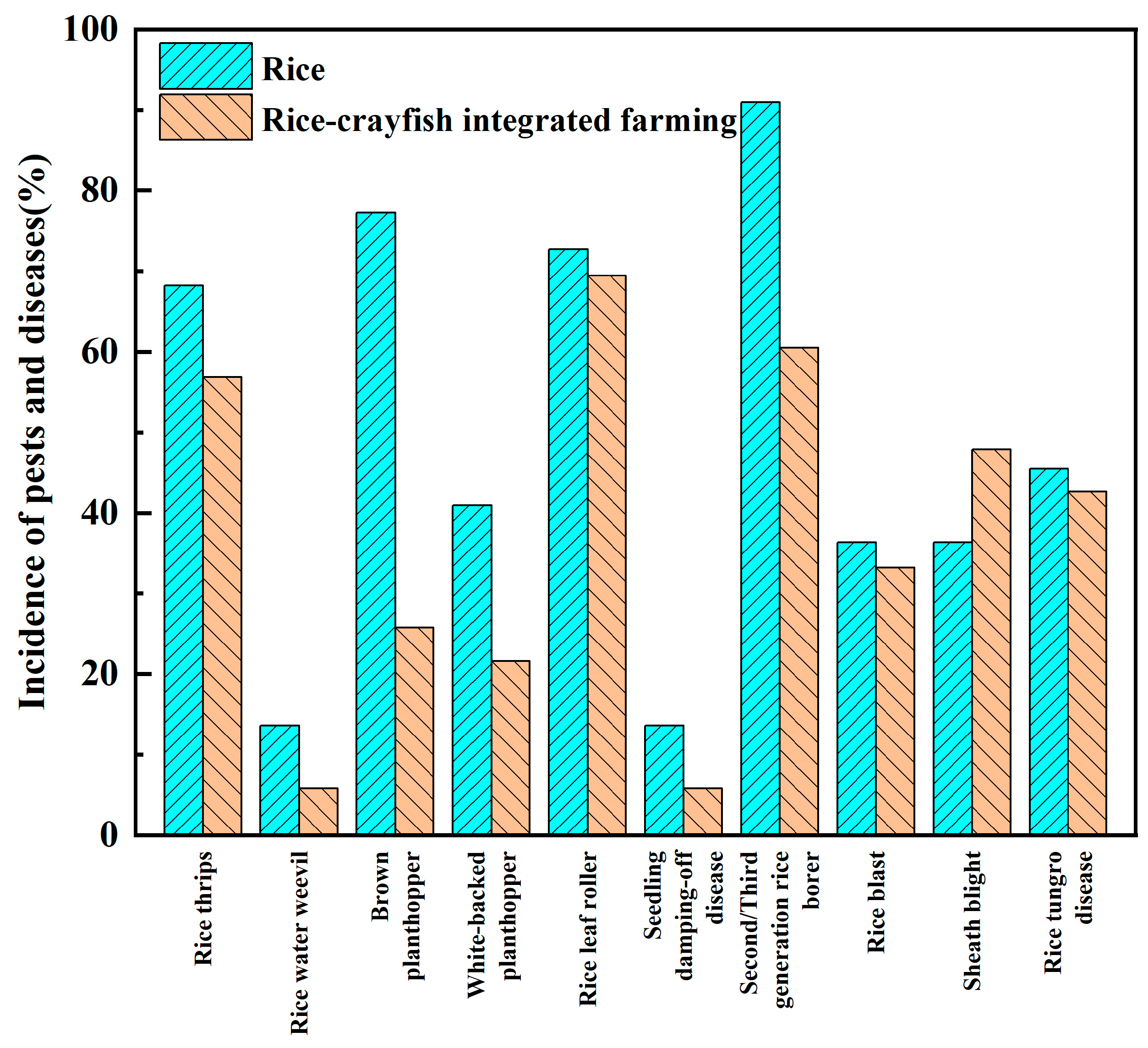Analysis and Prospects of the Economic, Social and Environmental Sustainability Benefits of the Integrated Rice–Aquaculture Farming System in China
Abstract
1. Introduction
- (1)
- Focus on the IRAFS, particularly related to the Chinese context.
- (2)
- Relevance to the sustainability benefits of IRAFS in terms of economic, environmental, and social impacts.
- (3)
- Peer-reviewed articles, reports, and reviews that provide scientific or empirical evidence on IRAFS.
- (4)
- Exclusion of studies that were unrelated to IRAFS or focused on non-sustainable farming practices.
2. Development and Current Status of Integrated Cultivation Model in Rice Fields
3. Benefit Analysis of the IRAFS
3.1. Economic Benefits
3.1.1. Increased Product Yields
3.1.2. Enhanced Overall Profit
3.2. Environmental Benefits
3.2.1. Reduction in Pesticide and Fertilizer Use
3.2.2. Reduction in Pollutant Emissions
3.2.3. Improvement of the Agricultural Ecosystem
3.3. Social Benefits
4. Existing Issues and Shortcomings
4.1. Impact on Total Rice Yield
4.2. Highest Income but Lowest Profit
4.3. Lack of Standardized Guidelines
4.4. Insufficient Promotion and Application
5. Prospect and Suggestion
Funding
Institutional Review Board Statement
Informed Consent Statement
Data Availability Statement
Conflicts of Interest
References
- Xu, Q.; Dai, L.; Zhou, Y.; Dou, Z.; Gao, W.; Yuan, X.; Gao, H.; Zhang, H. Effect of nitrogen application on greenhouse gas emissions and nitrogen uptake by plants in integrated rice-crayfish farming. Sci. Total Environ. 2023, 905, 167629. [Google Scholar] [CrossRef]
- Chen, Y.; Yu, P.; Wang, L.; Chen, Y.; Chan, E.H.W. The impact of rice-crayfish field on socio-ecological system in traditional farming areas: Implications for sustainable agricultural landscape transformation. J. Clean. Prod. 2024, 434, 139625. [Google Scholar] [CrossRef]
- Ye, Y.; Bai, H.; Zhang, J.; Sun, D. A comparative analysis of ecosystem service values from various rice farming systems: A field experiment in China. Ecosyst. Serv. 2024, 70, 101664. [Google Scholar] [CrossRef]
- Tan, W.; Wang, X.; Yan, L.; Yi, J.; Xia, T.; Zeng, Z.; Yu, G.; Chai, M.; Velpuri, N.M.; Thaneerat, A. Mapping rice-crayfish co-culture (RCC) fields with Sentinel-1 and -2 time series in China’s primary crayfish production region Jianghan Plain. Sci. Remote Sens. 2024, 10, 100151. [Google Scholar] [CrossRef]
- Adegbeye, M.J.; Ravi Kanth Reddy, P.; Obaisi, A.I.; Elghandour, M.M.M.Y.; Oyebamiji, K.J.; Salem, A.Z.M.; Morakinyo-Fasipe, O.T.; Cipriano-Salazar, M.; Camacho-Díaz, L.M. Sustainable agriculture options for production, greenhouse gasses and pollution alleviation, and nutrient recycling in emerging and transitional nations—An overview. J. Clean. Prod. 2020, 242, 118319. [Google Scholar] [CrossRef]
- Qi, Y.; Da, Y. The Empirical Research on the Food Prices, the Cost of Agricultural Production and the Income of Farmers based on VAR Model. Theory Pract. Financ. Econ. 2013, 34, 87–91+125. (In Chinese) [Google Scholar]
- Saowakoon, S.; Saowakoon, K.; Jutagate, A.; Hiroki, M.; Fukushima, M.; Jutagate, T. Growth and feeding behavior of fishes in organic rice–fish systems with various species combinations. Aquac. Rep. 2021, 20, 100663. [Google Scholar] [CrossRef]
- Li, Y.; Wu, T.; Wang, S.; Ku, X.; Zhong, Z.; Liu, H.; Li, J. Developing integrated rice-animal farming based on climate and farmers choices. Agric. Syst. 2023, 204, 103554. [Google Scholar]
- Ou, Y.; Bao, Z.; Ng, S.T.; Song, W.; Chen, K. Land-use carbon emissions and built environment characteristics: A city-level quantitative analysis in emerging economies. Land Use Policy 2024, 137, 107019. [Google Scholar] [CrossRef]
- Samaddar, A.; Kacha, D.; Kaviraj, A.; Freed, S.; Panemangalore, A.P.; Saha, S. Rice-fish coculture: Enhancing resource management and food security. Aquaculture 2025, 595, 741476. [Google Scholar] [CrossRef]
- Bashir, M.A.; Liu, J.; Geng, Y.; Wang, H.; Pan, J.; Zhang, D.; Rehim, A.; Aon, M.; Liu, H. Co-culture of rice and aquatic animals: An integrated system to achieve production and environmental sustainability. J. Clean. Prod. 2020, 249, 119310. [Google Scholar] [CrossRef]
- Khatri-Chhetri, A.; Sapkota, T.B.; Maharjan, S.; Cheerakkollil Konath, N.; Shirsath, P. Agricultural emissions reduction potential by improving technical efficiency in crop production. Agric. Syst. 2023, 207, 103620. [Google Scholar] [CrossRef]
- Yuan, P.; Wang, J.; Guo, C.; Guo, Z.; Guo, Y.; Cao, C. Sustainability of the rice–crayfish farming model in waterlogged land: A case study in Qianjiang County, Hubei Province, China. J. Integr. Agric. 2022, 21, 1203–1214. [Google Scholar] [CrossRef]
- Jiang, Y.; Cao, C. Crayfish–rice integrated system of production: An agriculture success story in China. A review. Agron. Sustain. Dev. 2021, 41, 68. [Google Scholar] [CrossRef]
- Sheng, F.; Cao, C.; Li, C. Integrated rice-duck farming decreases global warming potential and increases net ecosystem economic budget in central China. Environ. Sci. Pollut. Res. 2018, 25, 22744–22753. [Google Scholar] [CrossRef]
- Li, W.; He, Z.; Wu, L.; Liu, S.; Luo, L.; Ye, X.; Gao, H.; Ma, C. Impacts of co-culture of rice and aquatic animals on rice yield and quality: A meta-analysis of field trials. Field Crops Res. 2022, 280, 108468. [Google Scholar]
- Li, S.; Jiang, J.; Lv, W.G.; Siemann, E.; Woodcock, B.A.; Wang, Y.; Cavalieri, A.; Bai, N.; Zhang, J.; Zheng, X. Rice-fish co-culture promotes multiple ecosystem services supporting increased yields. Agric. Ecosyst. Environ. 2025, 381, 109417. [Google Scholar] [CrossRef]
- Ge, L.; Sun, Y.; Li, Y.; Wang, L.; Guo, G.; Song, L.; Wang, C.; Wu, G.; Zang, X.; Cai, X. Ecosystem sustainability of rice and aquatic animal co-culture systems and a synthesis of its underlying mechanisms. Sci. Total Environ. 2023, 880, 163314. [Google Scholar] [CrossRef] [PubMed]
- Guo, L.; Lin, W.; Cao, C.; Li, C. Integrated rice-crayfish farming system does not mitigate the global warming potential during rice season. Sci. Total Environ. 2023, 867, 161520. [Google Scholar] [CrossRef]
- Hu, L.; Zhang, J.; Ren, W.; Guo, L.; Cheng, Y.; Li, J.; Li, K.; Zhu, Z.; Zhang, J.; Luo, S. Can the co-cultivation of rice and fish help sustain rice production? Sci. Rep. 2016, 6, 28728. [Google Scholar] [CrossRef]
- Hou, Y.; Jia, R.; Zhou, L.; Zhang, L.; Sun, W.; Li, B.; Zhu, J. Integrated rice-fish farming dynamically altered the metal resistances and microbial-mediated iron, arsenic, and mercury biotransformation in paddy soil. Environ. Pollut. 2025, 373, 126107. [Google Scholar] [CrossRef]
- Hou, J.; Zhang, D.; Zhu, J. Nutrient accumulation from excessive nutrient surplus caused by shifting from rice monoculture to rice–crayfish rotation. Environ. Pollut. 2021, 271, 116367. [Google Scholar] [CrossRef]
- Li, W.; Liu, S.; Ye, X.; Gao, H.; Liu, R.; Li, D.; Yao, G. Effects of the Integrated Rice-crayfish Farming on Nitrogen Accumulation and Quality of Rice. J. Ecol. Rural Environ. 2021, 37, 661–667. (In Chinese) [Google Scholar]
- Li, M.; Li, R.; Liu, S.; Zhang, J.; Luo, H.; Qiu, S. Rice-duck Co-culture Benefits Grain 2-acetyl-1-pyrroline Accumulation and Quality and Yield Enhancement of Fragrant Rice. Crop J. 2019, 7, 419–430. [Google Scholar] [CrossRef]
- Hu, N.; Liu, C.; Chen, Q.; Zhu, L. Life cycle environmental impact assessment of rice-crayfish integrated system: A case study. J. Clean. Prod. 2021, 280, 124440. [Google Scholar] [CrossRef]
- Liu, M.; Yuan, J.; Ni, M.; Lian, Q. Assessment of the effectiveness of a field-scale combined ecological treatment system at removing water pollutants, after optimization using a system dynamic model: A case study of rural inland ponds in China. Environ. Sci. Pollut. Res. 2022, 29, 30169–30183. [Google Scholar] [CrossRef] [PubMed]
- Ren, Y.; Li, S.; Shao, J.; Xun, W.; Miao, Y.; Xu, Z.; Zhang, N.; Zhang, R.; Shen, Q. Integrating composite microorganism agents in rice-crayfish rotational cropping systems to enhance water quality and productivity. Environ. Technol. Innov. 2025, 39, 104280. [Google Scholar] [CrossRef]
- Tang, J.; Li, W.; Lv, X.; Wang, Y.; Ding, X.; Jiang, J.; Tang, Y.; Li, J.; Zhang, J.; Du, J. Development Status and Rethinking of the Integrated Rice-fish System in China. China Rice 2020, 26, 1–10. (In Chinese) [Google Scholar]
- Yu, X.; Hao, X.; Dang, Z.; Yang, L. Development Report on Integrated Rice-Fish Farming Industry in China (2023). China Fish. 2023, 8, 19–26. (In Chinese) [Google Scholar]
- Tan, S.; Zhang, Y.; Liu, Q.; Zhang, Q. Factors limiting the sustainable implementation of the rice-crayfish system in Hubei Province, China. Agric. Syst. 2024, 218, 104007. [Google Scholar] [CrossRef]
- GB/T 43508–2023; General Technical Requirements for Integrated Farming of Rice and Aquatic Animals. China Standard Press: Beijing, China, 2023.
- Wang, C.; Dong, J.; Zhou, Y.; Cui, Y.; Chen, X.; Di, Y.; Xiao, X.; Zhang, G. Satellite observed rapid inland aquaculture expansion in Jianghan Plain, China from 2016 to 2022. Aquaculture 2025, 599, 742132. [Google Scholar] [CrossRef]
- Zheng, L.; Rong, Y.; Guo, J.; Yan, Y.; Zhang, Y.; Zhao, Y.; Li, X.; Wang, R.; Zhang, J. Improving economic efficiency of traditional rice-fish symbiosis system for sustainable mountainous development: A case study of the world agricultural heritage in Qingtian, China. Ecol. Front. 2025, 45, 472–482. [Google Scholar] [CrossRef]
- Liu, H.; Jiang, W. Energy analysis and economic assessment of a rice-turtle-fish co-culture system. Agroecol. Sustain. Food Syst. 2019, 43, 299–309. [Google Scholar] [CrossRef]
- Feng, J.; Li, F.; Zhou, X.; Xu, C.; Fang, F. Nutrient removal ability and economical benefit of a rice-fish co-culture system in aquaculture pond. Ecol. Eng. 2016, 94, 315–319. [Google Scholar] [CrossRef]
- Ju, X.; Gu, B.; Wu, Y.; Galloway, J.N. Reducing China’s fertilizer use by increasing farm size. Glob. Environ. Change 2016, 41, 26–32. [Google Scholar] [CrossRef]
- Wu, Y.; Li, Y.; Niu, L.; Zhang, W.; Wang, L.; Zhang, H. Nutrient status of integrated rice-crayfish system impacts the microbial nitrogen-transformation processes in paddy fields and rice yields. Sci. Total Environ. 2022, 836, 155706. [Google Scholar] [CrossRef]
- Nie, Z.; Xu, X.; Ji, Y.; Gao, P.; Zhou, S.; Sun, Y.; He, J.; Wang, L.; Shao, N.; Shi, Y.; et al. Rice-fish co-culture improves carp (Cyprinus carpio) quality by modulating the gut microbiota and metabolites. Aquaculture 2025, 607, 742659. [Google Scholar] [CrossRef]
- Meng, C.; Tian, W.; Wen, C.; Weng, X.; Ni, C.; Xu, Z. Development Characteristics and Countermeasures of Rice-Fishing Farming Industry in Jiangxi. China Rice 2022, 28, 28–31+37. (In Chinese) [Google Scholar]
- Chen, P.; Gu, J.; Song, Y.; Dong, M. Analysis of the Benefits and Key Technologies of Various Integrated Rice Farming Systems. Anhui Agric. Sci. Bull. 2021, 27, 54–55+62. (In Chinese) [Google Scholar]
- Liang, Y.; Yu, Z.; Zhao, Y.; Kuang, W.; Dai, L.; Kuang, N.; Fang, B. Rice-fish co-culture mode: A review. Chin. J. Ecol. 2023, 42, 2747–2755. (In Chinese) [Google Scholar]
- Qin, C.; He, J.; Yu, C.; Sun, A.; Li, K.; Hu, H.; Hu, T.; Ye, Y.; Yu, Y.; Wang, H. Evaluating the water quality of the rice–fish co-culture pattern based on the modified NSF water quality index model. Aquaculture 2025, 597, 741931. [Google Scholar] [CrossRef]
- Zhang, H.; Wang, L.; Jiang, S.; Li, K.; Xin, X.; Huang, X.; Chen, J.; Zhou, L.; Li, Z. Impacts of rice–crayfish co-culture on ecosystem service trade-offs/synergies in agricultural watersheds: A case exploration in Sihu Lake Basin, China. Agric. Water Manag. 2025, 310, 109389. [Google Scholar] [CrossRef]
- Liu, T.; Li, C.; Tan, W.; Wang, J.; Feng, J.; Hu, Q.; Cao, C. Rice-crayfish co-culture reduces ammonia volatilization and increases rice nitrogen uptake in central China. Agric. Ecosyst. Environ. 2022, 330, 107869. [Google Scholar] [CrossRef]
- Chen, W.; Peng, L.; Liu, Y.; Li, G.; Yao, Y. The economic effects and ecological effects of the rice-crayfish integrated systems in Jianghan plain. Hubei Agric. Sci. 2019, 58, 160–166. (In Chinese) [Google Scholar]
- Xu, Q.; Peng, X.; Guo, H.; Che, Y.; Dou, Z.; Xing, Z.; Hou, J.; Styles, D.; Gao, H.; Zhang, H. Rice-crayfish coculture delivers more nutrition at a lower environmental cost. Sustain. Prod. Consum. 2022, 29, 14–24. [Google Scholar] [CrossRef]
- Chen, K.; Yu, M.; Cheng, B.; Cao, C.; Jiang, Y. Co-cultivation of rice and aquatic animals: Improving soil fertility and providing more rice in China. Soil Tillage Res. 2025, 251, 106526. [Google Scholar] [CrossRef]
- Liu, Y.; Qin, L.; Li, F.; Zhou, X.; Xu, C.; Ji, L.; Chen, Z.; Feng, J.; Fang, F. Impact of Rice-Catfish/Shrimp Co-culture on Nutrients Fluxes Across Sediment-Water Interface in Intensive Aquaculture Ponds. Rice Sci. 2019, 26, 416–424. [Google Scholar]
- Bashir, M.A.; Xu, Y.; Wang, H.; Zhang, Y.; Raza, Q.-u.-A.; Sun, W.; Aon, M.; Zhang, X.; Rehim, A.; Liu, H. Integrated rice-crab co-culture system shows capability to reduce greenhouse gases emission and global warming potential. Aquaculture 2025, 598, 742047. [Google Scholar] [CrossRef]
- Zhang, Z.; Liu, F.; Hou, T. Current status of nitrogen and phosphorus losses and related factors in Chinese paddy fields: A review. Chin. J. Appl. Ecol. 2019, 30, 3292–3302. (In Chinese) [Google Scholar]
- Zhang, D.; Yang, Y.; Liu, K.; Zhu, J.; Hou, J. Nitrogen-phosphorus balance and economic benefit of rice-crawfish culture under different fertilization patterns. Soils Fertil. Sci. China 2020, 124–129. (In Chinese) [Google Scholar]
- Yang, T.; Wang, X.; Wang, M.; Li, F.; Barthel, M.; Six, J.; Feng, J.; Fang, F. Impact of rice-crab and rice-fish co-cultures on the methane emission and its transport in aquaculture ponds. Agric. Ecosyst. Environ. 2025, 378, 109281. [Google Scholar] [CrossRef]
- Li, F.; Feng, J.; Zhou, X.; Xu, C.; Haissam Jijakli, M.; Zhang, W.; Fang, F. Impact of rice-fish/shrimp co-culture on the N2O emission and NH3 volatilization in intensive aquaculture ponds. Sci. Total Environ. 2019, 655, 284–291. [Google Scholar] [CrossRef]
- Liu, X.; Sun, D.; Huang, H.; Zhang, J.; Zheng, H.; Jia, Q.; Zhao, M. Rice-fish coculture without phosphorus addition improves paddy soil nitrogen availability by shaping ammonia-oxidizing archaea and bacteria in subtropical regions of South China. Sci. Total Environ. 2024, 927, 171642. [Google Scholar] [CrossRef]
- Tao, L.; Peng, L.; Dai, L.; Yang, Z.; Chen, S.; Ke, Y.; Li, G. Characteristics of non-point source pollution emission of rice-crayfish rotation system and its emergy analysis. J. Lake Sci. 2023, 35, 168–180. (In Chinese) [Google Scholar]
- Dong, Y.; Li, B.; Jia, R.; Hou, Y.; Diao, W.; Zhu, J. Life Cycle Environmental Impact Assessment on Two Aquaculture Models in the Yangtze River Basin. Prog. Om Fish. Sci. 2024, 45, 23–32. (In Chinese) [Google Scholar]
- Zhu, J.; Liu, H.; Wu, B.; Yuan, F.; Liu, Z.; Jin, T. Effects of integrated rice-crayfish farming system on community structure and diversity of nirK denitrification microbe in paddy soils. Chin. J. Eco-Agric. 2018, 26, 1324–1332. (In Chinese) [Google Scholar]
- Tang, W.; Chen, C.; Huang, H. Effects of Different Rice Cultivation Patterns on Soil and Water Physical and Chemical Properties and Rice Yield. Crop Res. 2021, 35, 490–495. (In Chinese) [Google Scholar]
- Hou, Y.; Jia, R.; Zhou, L.; Zhang, L.; Wei, S.; Li, B.; Zhu, J. Alterations in microbial-mediated methane, nitrogen, sulfur, and phosphorus cycling within paddy soil induced by integrated rice-fish farming. J. Environ. Manag. 2025, 388, 126056. [Google Scholar] [CrossRef]
- Ren, L.; Liu, P.; Xu, F.; Gong, Y.; Zhai, X.; Zhou, M.; Wang, J.; Wang, Z. Rice–fish coculture system enhances paddy soil fertility, bacterial network stability and keystone taxa diversity. Agric. Ecosyst. Environ. 2023, 348, 108399. [Google Scholar] [CrossRef]
- Fan, L.; Li, F.; Chen, X.; Shen, L.; Chu, Y.; Qiu, L.; Hu, G.; Song, C.; Li, D.; Meng, S.; et al. Co-culture of red swamp crayfish Procambarus clarkia influenced glycoside hydrolase families and fungal communities in the rice-paddy soils. Appl. Soil Ecol. 2023, 186, 104816. [Google Scholar] [CrossRef]
- Zhang, Y.; Wang, B.-Y.; Zhang, J.; Liu, Y.-H.; Tang, D.-Y.; Zhao, J.; Dai, C.-C. By reconstructing a multifunctional intensive microbiome, effective microorganisms (EM) improve the ecological environment of rice–crayfish cocropping. Agric. Ecosyst. Environ. 2023, 357, 108698. [Google Scholar] [CrossRef]
- Chen, Y.; Yu, P.; Chen, Y.; Chen, Z. Spatiotemporal dynamics of rice–crayfish field in Mid-China and its socioeconomic benefits on rural revitalisation. Appl. Geogr. 2022, 139, 102636. [Google Scholar] [CrossRef]
- Peng, S.; Liu, Q.; Yang, Y.; Wu, X.; Zhou, J.; Xiao, H.; Li, M.; Wu, H.; Gu, Y. Construction of benefit evaluation index system of rice-fish co-cropping model: A case study of Chenxi County, Hunan Province. Jiangsu Agric. Sci. 2018, 46, 442–444. (In Chinese) [Google Scholar]
- Wang, X.; Tian, Z.; Yang, C.; Qi, Z.; Chen, S. Can the adoption of rice-aquaculture integrated cultivation mode improve farmers benefits? A case study of rice and crayfish coculture pattern. J. China Agric. Univ. 2023, 28, 259–274. (In Chinese) [Google Scholar]
- Luo, Q.; Dai, R.; Zhao, L.; Zhang, T.; Ye, J.; Tang, J.; Hu, L.; Chen, X. Traditional rice-fish system benefits sustainable production of small farms and conservation of local resources. Agric. Syst. 2025, 228, 104398. [Google Scholar] [CrossRef]
- Chen, B.; Guo, L.; Tang, J.; Li, Y.; Li, C. Comprehensive impacts of different integrated rice-animal co-culture systems on rice yield, nitrogen fertilizer partial factor productivity and nitrogen losses: A global meta-analysis. Sci. Total Environ. 2024, 915, 169994. [Google Scholar] [CrossRef] [PubMed]
- Yuan, P.; Wang, J.; Li, C.; Xiao, Q.; Liu, Q.; Sun, Z.; Wang, J.; Cao, C. Soil quality indicators of integrated rice-crayfish farming in the Jianghan Plain, China using a minimum data set. Soil Tillage Res. 2020, 204, 104732. [Google Scholar] [CrossRef]
- Yang, X.; Deng, X.; Zhang, A. Does conservation tillage adoption improve farmers’ agricultural income? A case study of the rice and fish co-cultivation system in Jianghan Plain, China. J. Rural Stud. 2023, 103, 103108. [Google Scholar] [CrossRef]
- Tu, V.H.; Kopp, S.W.; Trang, N.T.; Hong, N.B.; Yabe, M. Land accumulation: An option for improving technical and environmental efficiencies of rice production in the Vietnamese Mekong Delta. Land Use Policy 2021, 108, 105678. [Google Scholar] [CrossRef]
- Fertin, L.; Perinelle, A.; Bakker, T. From pond to lowland scale, a systemic approach to better understanding small-scale rice-fish farming dynamics: Case study in Guinea. Agric. Syst. 2025, 228, 104383. [Google Scholar] [CrossRef]
- Wang, L.; Chen, J. Economic and Social Benefits of Aquavoltaics: A Case Study from Jiangsu, China. Sustainability 2024, 16, 9060. [Google Scholar] [CrossRef]
- Sathoria, P.; Roy, B. Sustainable food production through integrated rice-fish farming in India: A brief review. Renew. Agric. Food Syst. 2022, 37, 527–535. [Google Scholar] [CrossRef]




| Year | Policies, Promotion and Research Situations |
|---|---|
| 2011 | The Ministry of Agriculture and Rural Affairs of the People’s Republic of China (MARA) incorporated rice–fish integrated farming into the National Fisheries Development Twelfth Five-Year Plan (2011–2015) |
| 2012 | The initiative ”Technology Integration and Demonstration Extension of Rice-Fish Integrated Farming” received special funding support from MARA to accelerate its nationwide application and standardization |
| 2015 |
|
| 2016 | China’s key policy plans, including the Chinese central government’s No. 1 Central Document, explicitly endorse the expansion of rice–fish farming as a means to enhance agricultural sustainability. |
| 2017 | MARA issued the ”General Technical Requirements for Rice-Fish Integrated Farming” industry standard to standardize and promote sustainable practices in rice–fish co-culture systems. |
| 2020 | MARA issued the ”Technical Guidelines for Rice-Fish Integrated Farming Production” to standardize practices and promote green, high-quality development in rice–fish co-culture systems. |
| 2022 | MARA issued the Guidelines on Promoting the High-Quality Development of the Rice–Fish Integrated Farming Industry, emphasizing a strategic shift from quantity-driven expansion to quality-oriented development in the integrated farming model. This transition focuses on ecological sustainability, technological innovation, and coordinated rural revitalization, aligning with national goals for food security and agricultural modernization. |
| 2024 | The National Standard “General technical requirements for integrated farming of rice and aquatic animals”, as the first of its kind in the field, has entered into force on 1 July 2024 [31]. It provides a critical framework for regulating production practices and promoting the high-quality development of the rice–fish integrated farming industry. |
| Cropping System | Nitrogen Loss Amount/(kg/ha) | Phosphorus Loss Amount/(kg/ha) |
|---|---|---|
| single-cropping (China’s six major rice-growing regions) | 16.59 | 0.89 |
| single-cropping (Chaohu Lake) | 14.58 | 1.41 |
| Rice–shrimp co-culture models | 31.72 | 1.43 |
| Chinese freshwater prawn | 37.20 | 7.78 |
| Litopenaeus vannamei | 181.00 | 46.80 |
| Macrobrachium rosenbergii | 148.00 | 34.50 |
Disclaimer/Publisher’s Note: The statements, opinions and data contained in all publications are solely those of the individual author(s) and contributor(s) and not of MDPI and/or the editor(s). MDPI and/or the editor(s) disclaim responsibility for any injury to people or property resulting from any ideas, methods, instructions or products referred to in the content. |
© 2025 by the authors. Licensee MDPI, Basel, Switzerland. This article is an open access article distributed under the terms and conditions of the Creative Commons Attribution (CC BY) license (https://creativecommons.org/licenses/by/4.0/).
Share and Cite
Zhang, W.; Yu, C.; Wang, Z.; Hu, Y.; Han, C.; Long, M. Analysis and Prospects of the Economic, Social and Environmental Sustainability Benefits of the Integrated Rice–Aquaculture Farming System in China. Sustainability 2025, 17, 9372. https://doi.org/10.3390/su17219372
Zhang W, Yu C, Wang Z, Hu Y, Han C, Long M. Analysis and Prospects of the Economic, Social and Environmental Sustainability Benefits of the Integrated Rice–Aquaculture Farming System in China. Sustainability. 2025; 17(21):9372. https://doi.org/10.3390/su17219372
Chicago/Turabian StyleZhang, Wei, Chan Yu, Zhenhua Wang, Yanping Hu, Cheng Han, and Meng Long. 2025. "Analysis and Prospects of the Economic, Social and Environmental Sustainability Benefits of the Integrated Rice–Aquaculture Farming System in China" Sustainability 17, no. 21: 9372. https://doi.org/10.3390/su17219372
APA StyleZhang, W., Yu, C., Wang, Z., Hu, Y., Han, C., & Long, M. (2025). Analysis and Prospects of the Economic, Social and Environmental Sustainability Benefits of the Integrated Rice–Aquaculture Farming System in China. Sustainability, 17(21), 9372. https://doi.org/10.3390/su17219372






